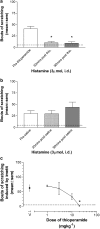Involvement of histamine H4 and H1 receptors in scratching induced by histamine receptor agonists in Balb C mice
- PMID: 15066908
- PMCID: PMC1574944
- DOI: 10.1038/sj.bjp.0705754
Involvement of histamine H4 and H1 receptors in scratching induced by histamine receptor agonists in Balb C mice
Abstract
The role of histamine H(1), H(2), H(3) and H(4) receptors in acute itch induced by histamine was investigated in female BalbC mice. Scratching was induced by intradermal injections of pruritogen into the back of the neck and "itch" assessed by quantifying the scratching evoked. Histamine (0.03-80 micromol), histamine-trifluoromethyl-toluidine (HTMT, H(1) agonist, 0.002-2 micromol), clobenpropit (H(4) agonist, H(3) antagonist, 0.002-0.6 micromol) and to a lesser extent imetit (H(3)/H(4) agonist, 0.03-3 micromol) all induced dose-dependent scratching. Dimaprit (H(2) agonist, 0.04-40 micromol) did not cause scratching. Mepyramine (H(1) antagonist, 20 mg kg(-1), i.p.) reduced scratching evoked by histamine and HTMT, but not that caused by H(3) or H(4) agonists. Thioperamide (H(3)/H(4) antagonist, 20 mg kg(-1), i.p.) reduced scratching induced by histamine, H(3) and H(4) agonists, but not that caused by HTMT. The non-sedating H(1) antagonist, terfenadine, also significantly reduced the scratching induced by the H(1) agonist, HTMT. Cimetidine (H(2) antagonist, 20 mg kg(-1), i.p.) did not affect histamine-induced scratching. These results indicate that activation of histamine H(4) receptors causes itch in mice, in addition to the previously recognised role for H(1) receptors in evoking itch. Histamine H(4) receptor antagonists therefore merit investigation as antipruritic agents.
Figures






References
-
- AMANO R., HIRUMA H., NISHIDA S., KAWAKAMI T., SHIMIZU K. Inhibitory effect of histamine on axonal transport in cultured mouse dorsal root ganglion neurons. Neurosci. Res. 2001;41:201–206. - PubMed
-
- DRAKE L.A., FALLON J.D., SOBER A. Relief of pruritus in patients with atopic dermatitis after treatment with topical doxepin cream. The Doxepin Study Group. J. Am. Acad. Dermatol. 1994;31:613–616. - PubMed
-
- EKBLOM A. Some neurophysiological aspects of itch. Semin. Dermatol. 1995;14:262–270. - PubMed
-
- GREAVES M.W. Anti-itch treatments: do they work. Skin Pharmacol. 1997;10:225–229. - PubMed
Publication types
MeSH terms
Substances
LinkOut - more resources
Full Text Sources
Other Literature Sources
Medical
Research Materials

